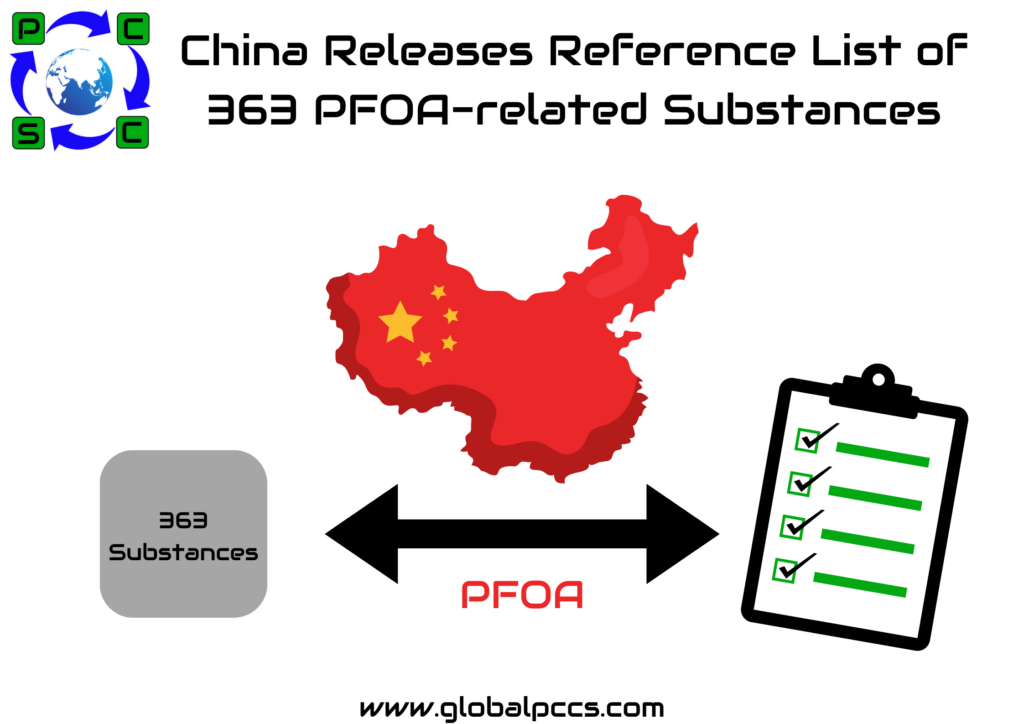 Businesses can use this list as a guide to make sure they are complying with the Inventory of Severely Restricted Toxic Chemicals (2023) and the List of New Pollutants for Priority Management (2023).
Businesses can use this list as a guide to make sure they are complying with the Inventory of Severely Restricted Toxic Chemicals (2023) and the List of New Pollutants for Priority Management (2023).
China’s Solid Waste and Chemicals Management Center (SCC) under the Ministry of Ecology and Environment (MEE) released on 2 November 2023 the Reference List of PFOA, Its Salts and PFOA-related Compounds. This list includes 363 substances with CAS numbers and HS codes. They are recognized as PFOA, its salts and PFOA-related compounds that are subject to certain control measures in China.
Background
PFOA, its salts, and compounds related to PFOA are a class of compounds in the widely recognized PFAS family. They could seriously or permanently damage the environment if they are not controlled. They were included in Annex A of the Stockholm Convention on Persistent Organic Pollutants in 2019 and Annex III of the Rotterdam Convention in 2022 as compounds of high concern. China has proposed laws to phase out PFOA, its salts, and chemicals linked to PFOA because it is a party to these two international accords. The MEE published the List of New Pollutants for Priority Management (2023) on December 31, 2022. This list, also known as the 2023 List, includes “PFOA, its salts, and PFOA-related compounds” with stringent control measures. In order to address the 2023 List, the MEE published the Inventory of Severely Restricted Toxic Chemicals (2023) on October 18, 2023, which is also known as the 2023 Inventory. This release included the addition of “PFOA, its salts, and PFOA-related compounds” along with usage guidelines. However, this class of compounds is not assigned a CAS number or other identification number. The Reference List of PFOA, Its Salts, and PFOA-related Compounds was recently released by the SCC-MEE to assist enterprises in ensuring compliance activities.
Control measures
According to the 2023 List and 2023 Inventory, major control measures for PFOA, its salts and PFOA-related compounds include:
- Prohibition on the establishment of new installations for relevant production equipment
- Prohibition on the manufacture and processing of these chemicals
- Prohibition on the use of these chemicals (with specific exemptions*)
- Import or export of these chemicals shall obtain the Clearance Notification for Environmental Management on Import/Export of Toxic Chemicals from the MEE (permitted only for specific usages**) etc.
Specific exemptions* & Specific usages**
The “specific exemptions” (specified in the 2023 List) and the “specific usages” (specified in the 2023 Inventory) are the same, including:
- Photolithography or etch processes in semiconductor manufacturing
- Photographic coatings applied to films
- Textiles for oil and water repellency for the protection of workers from dangerous liquids that comprise risks to their health and safety
- Invasive and implantable medical devices
- Use of perfluorooctyl iodide for the production of perfluorooctyl bromide for the purpose of producing pharmaceutical products
- Manufacture of polytetrafluoroethylene (PTFE) and polyvinylidene fluoride (PVDF) for the production of:
- High-performance, corrosion-resistant gas filter membranes, water filter membranes and membranes for medical textiles
- Industrial waste heat exchanger equipment
- Industrial sealants capable of preventing leakage of volatile organic compounds and PM2.5 particulates
- Manufacture of polyfluorene ethylene propylene (FEP) for the production of high-voltage electrical wire and cables for power transmission








 Authorised IMDS & CDX Training & Consulting partner for
Authorised IMDS & CDX Training & Consulting partner for






